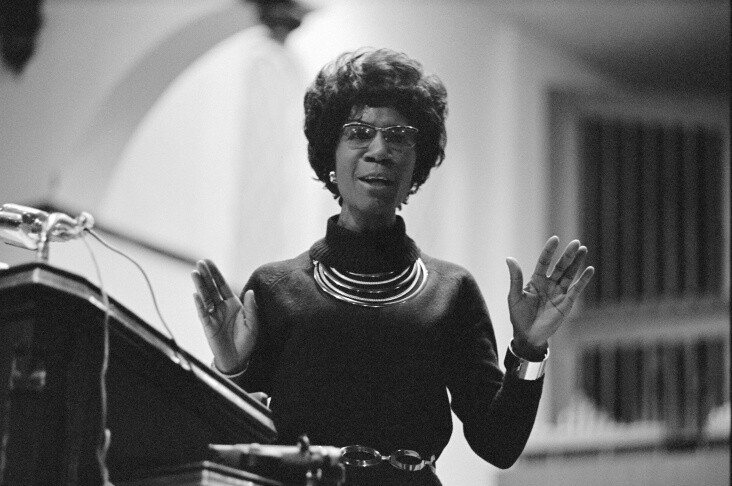Truth matters. Community matters. Your support makes both possible. LAist is one of the few places where news remains independent and free from political and corporate influence. Stand up for truth and for LAist. Make your year-end tax-deductible gift now.
Virtual Exhibit: The Photos Of John Simmons Capture The Beauty And Struggles Of Black Americans

Our news is free on LAist. To make sure you get our coverage: Sign up for our daily newsletters. To support our non-profit public service journalism: Donate Now.
John Simmons began taking photographs as a teenager in 1965, the same year the Voting Rights Act was passed, guaranteeing all Black Americans the right to vote.
His current exhibition, "Capturing Beauty," assembles photos and artworks featuring notable figures in the civil rights movement and more everyday moments of life.
Simmons, a cinematographer, painter and photographer, said when he first started out, "there weren't that many positive images of Black people and publications unless you were looking at Jet magazine, or Ebony Magazine, or the Chicago Defender newspaper and the other black publications of the country."
Asked about one image in the collection of a little girl eating ice cream, taken in 1967, Simmons said:
"The picture has this kind of sweet, sincere, beautiful warmth to it. That basically, pretty much says a lot about the other photographs that are in the exhibit, you know, all the pictures that I take. I feel like I have a certain intimacy to the subjects because they're close to me. And they represent the experiences that I've lived through. And every time I take a picture, it pretty much represents my entire life and the way I see things. And in that exhibit, you'll see photographs of street light and street life in Chicago, and Los Angeles in New York. Angela Davis is in the exhibit."



HIS MENTORS
Growing up in Chicago at the height of the fight for Black civil rights shaped Simmons as an artist.
"Every artist is nurtured by the culture and the experiences of their lives," Simmons said. "And it shapes our vision, the way we see our life, and the way we want to communicate with people. It also becomes our mode of expression, it becomes our music, it becomes our poetry, it becomes our dance."
Simmons said he was first inspired by the work of Roy DeCarava, whose photos and his work with Langston Hughes on the book "Sweet Flypaper Of Life," which captured Harlem in the 1950s. He considers Bobby Sengstacke, a fellow photographer whose family owned the Chicago Defender, a mentor. Through Sengstacke, Simmons met noted photographers such as Gordon Parks.
A scholarship sent Simmons from his hometown of Chicago to Nashville to attend Fisk University, and the exhibit includes work from that time.

THE WEIGHT OF HISTORY
Simmons, 70, said slavery didn't feel like history to him as a child, noting his father was 12 years old when Harriet Tubman died.
"That puts slavery almost as a current event in my life because he was born in Alabama," Simmons said.
"That had a lot to do with the struggle we were up against. And my images were shaped by that struggle. I was nurtured by that kind of childhood and that kind of upbringing," he said.
Because of the pandemic, Simmons' exhibit is housed in the Boyle Heights gallery, CASA 0101, but not open physically to the public. Instead, you can tour it virtually, with Simmons and art curator Jimmy Centeno as your guides. (see below).
Simmons sees a silver lining in going virtual. Those interested, he said, now have "24-hour access around the world."
"I have a friend in Portugal, who was very up on what's going on in Los Angeles," said Simmons, "and no sooner than the conversation in the website was up, he hits me in the morning and tells me he's seen it. I mean, that wouldn't have happened without the pandemic, because we're stuck at home watching things that happen on the news, we're glued to our cell phones and our computers. And the communication just takes on a broader perspective."


THE ROLE OF PHOTOGRAPHY
Simmons believes using a camera is more critical to progress than ever before, especially in the pandemic where screen time is way up. He notes how significant the cell phone recording of George Floyd's murder has become: "That statement was made throughout the world. There was a horrible situation in India and the crowd outside the police station was yelling, 'We will not be George Floyd.'"
But don't let it all live on the Internet alone. He urges young photographers to be aware of the significance of holding a printed image.
Simmons says from family photos to works of art, there's power in holding a printed photo. "I feel like it's important for us to put things on paper."
"And it's important to put them up on walls and people to be able to have them in the archive," he said. "This morning, my wife showed me a little Polaroid of her being held by her cousin. She was a baby. She's no longer with us, and that picture isn't a very good picture. But that picture is so important."
"Capturing Beauty: The Artwork and Photography of John Simmons" is on display at The Jean Deleage Art Gallery at CASA 0101 Theater through June 5. You can hear more from Simmons and watch a virtual walkthrough of the exhibit below.
A CONVERSATION WITH JOHN SIMMONS
GUIDED TOUR








